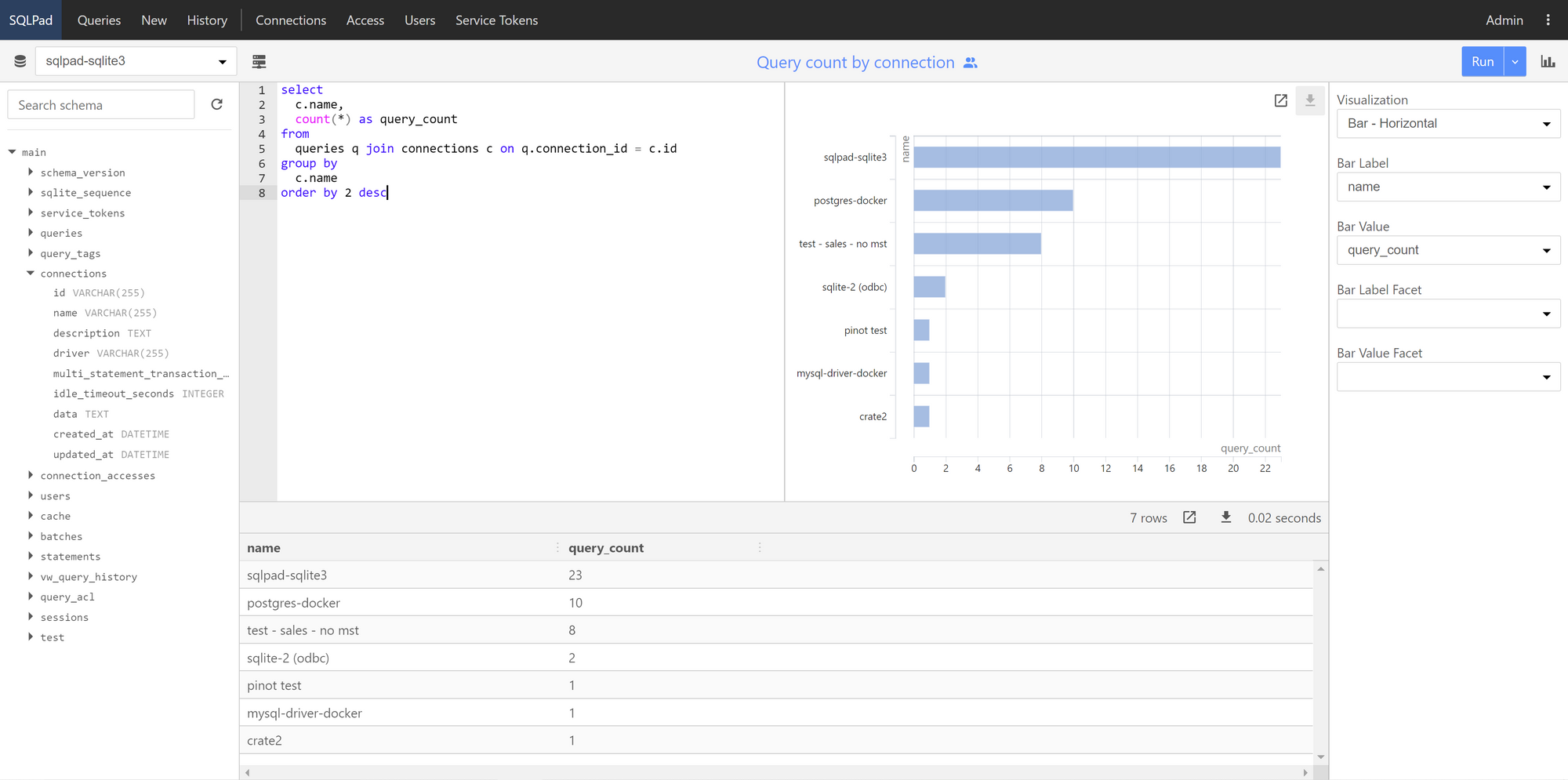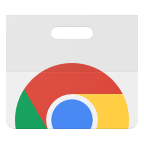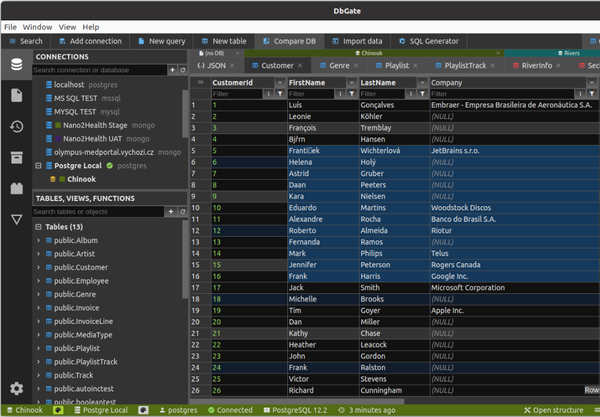25 Best Free SQL Viewers and Clients for 2024
An SQL Viewer is a valuable tool for various professionals and students involved in working with databases, offering a convenient and efficient way to interact with and analyze data using SQL queries.
Table of Content
What is an SQL Viewer?
An SQL Viewer is a software application that provides users with a convenient and efficient way to interact with databases using SQL queries.
This powerful tool offers a user-friendly interface that allows users to easily execute queries, explore data, and visualize results in a visually appealing manner.
With an SQL Viewer, users can effortlessly navigate through complex databases, analyze data from multiple tables, and gain valuable insights.
Embracing the capabilities of an SQL Viewer can empower users to make informed decisions, uncover hidden patterns, and extract meaningful information from their databases.
Use-Cases of SQL Viewer Apps!
- Students can use an SQL Viewer to practice writing and executing SQL queries, as well as to analyze and understand database structures and data.
- Developers can utilize an SQL Viewer to debug and optimize queries, test database integrations, and perform data analysis tasks.
- Data engineers can use an SQL Viewer to manage and monitor database systems, design and implement database schemas, and optimize database performance.
- DevOps professionals can leverage an SQL Viewer to manage and automate database deployments, monitor query performance, and troubleshoot database issues.
- Data scientists can utilize an SQL Viewer to extract and transform data, perform complex analytical queries, and generate insights from large datasets.
- Software engineers can use an SQL Viewer to interact with databases during application development, test and validate database operations, and analyze data for debugging purposes.
- Database engineers can utilize an SQL Viewer to design and optimize database structures, manage database security and access controls, and monitor database performance.
Benefits of using SQL Viewers!
- Easy query execution and data exploration.
- Visual representation of query results.
- Efficient database management and monitoring.
- Simplified data analysis and reporting.
- Enhanced collaboration and knowledge sharing.
- Streamlined debugging and optimization of queries.
- Time-saving and improved productivity.

1- Antares SQL
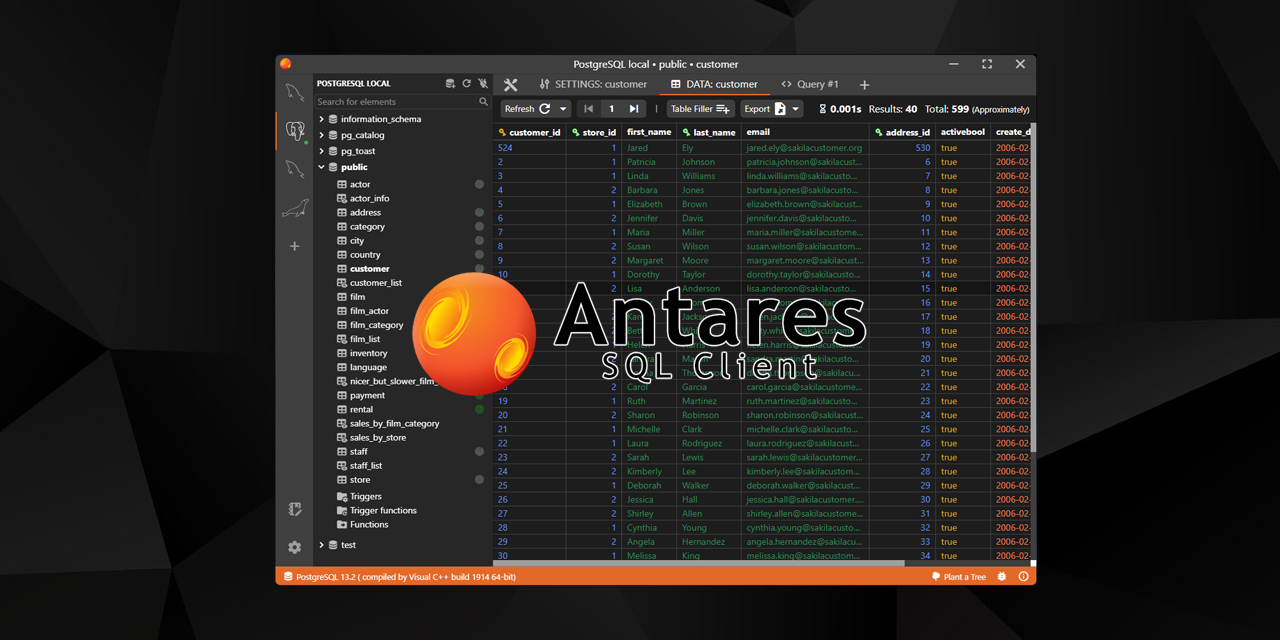
Antares is an SQL client tool built with Electron.js and Vue.js. It aims to be a useful tool for developers, supporting multiple databases and operating systems, including ARM versions.
Supported Databases
- MySQL
- MariaDB
- PostgreSQL
- SQLite
- Firebird SQL
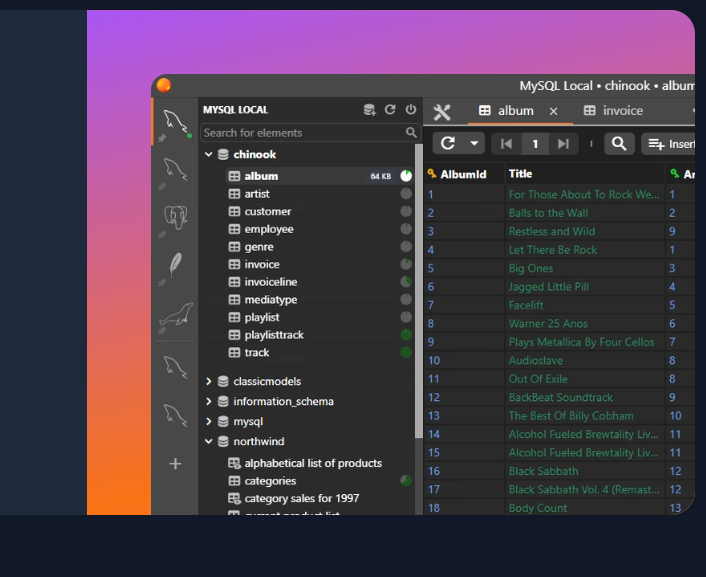
2- sqlite-gui
sqlite-gui is a powerful and efficient SQLite editor for Windows, built using C++/ mingw64/ WinAPI. It is designed to be lightweight, simple, and fast, making it an excellent choice for managing SQLite databases.
Pros
- Lightweight and easy to use
- Powerful functionality for managing SQLite databases
- Fast performance
- Free to use
Features
- Syntax highlighting and code completion
- Edit multiple tables at the same time
- Colorized data grid
- Store an execution history and user scripts
- Export/Import data
- Database diagram
- Database comparison
- Search text in the whole database
- Quick data references
- Terminal mode
- Charts
- Query parameters
- Query shortcuts
- Custom functions
- Jinja scripting (experimental)
- Data generator
- Extension pack
- Built-in REST API web server
- Demo database "Bookstore" for beginners
- Does not require installation
Cons
- Supports only SQLite
- Supports only Windows platforms
3- DBeaver
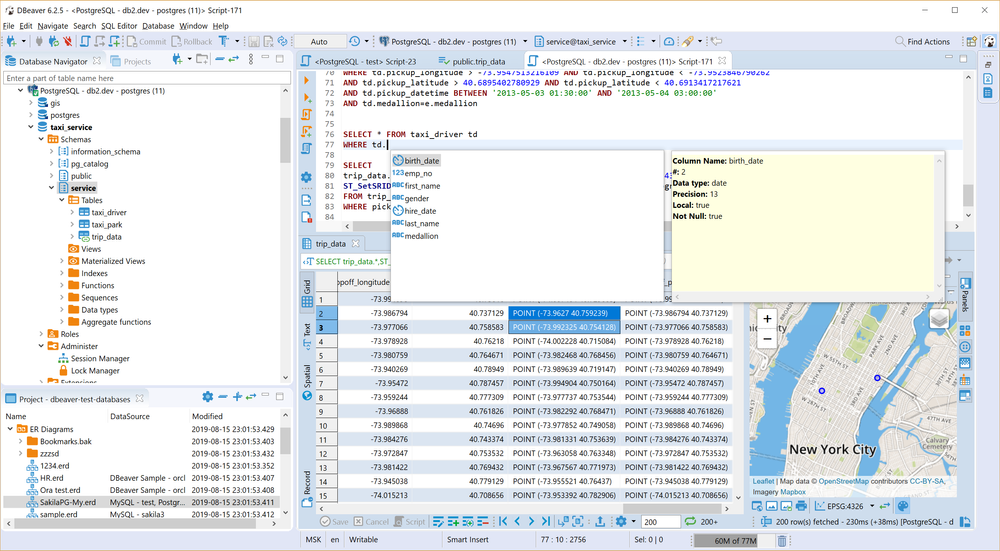
DBeaver is a free multi-platform database tool that supports any database with a JDBC driver. It is useful for developers, SQL programmers, database administrators, and analysts.
Commercial versions also support non-JDBC datasources like MongoDB, Cassandra, and Redis.
Supported platforms
- Windows
- macOS
- Linux
4- OpenDBViewer
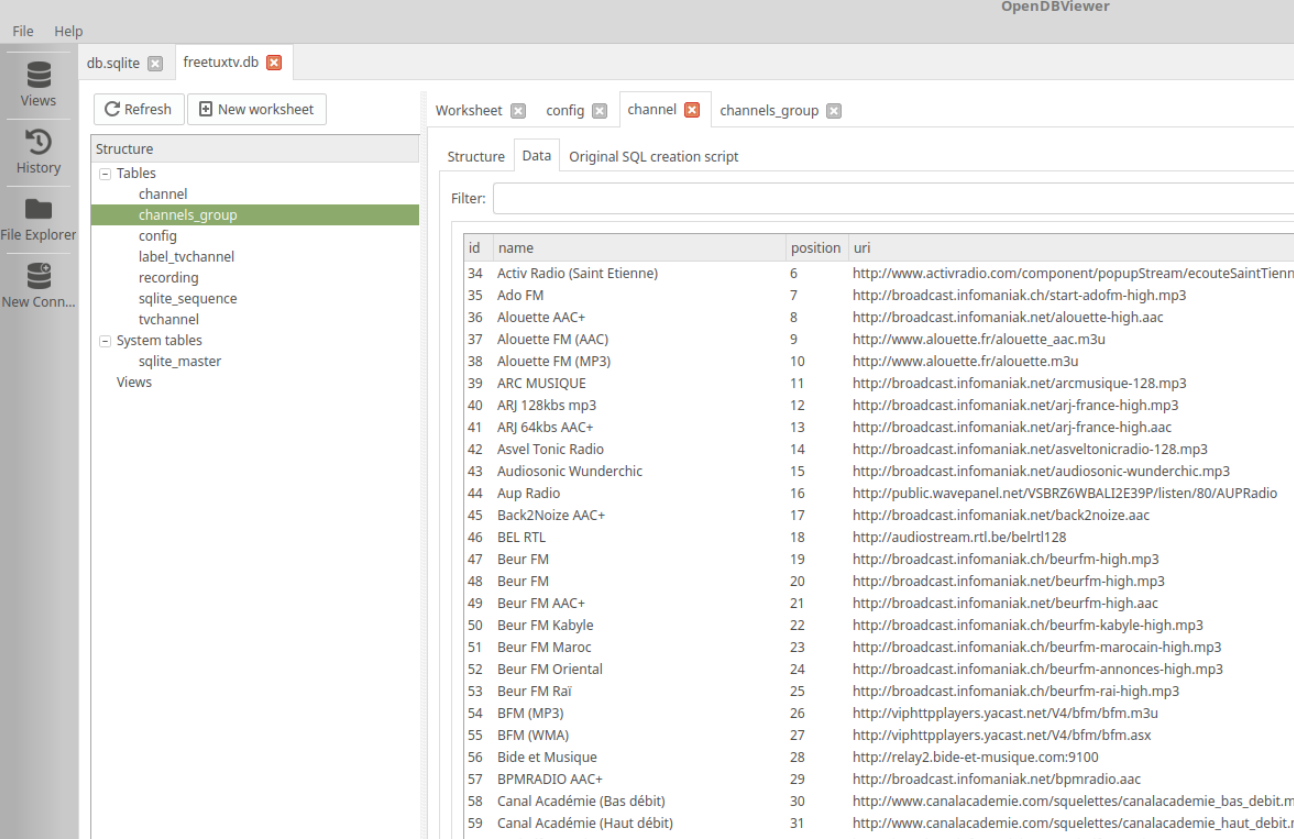
OpenDBViewer is a cross-platform database explorer for Windows, Linux, and macOS that allows users to view SQL databases.
Features
- Compatibility with SQLite, MySQL, PostgreSQL database.
- SQL syntax highlightings
- Multi database, table and worksheet view
- Big database loading
- Open SQLite table directly with drag'n drop
- History of last connection
- Edit database directly from the table view
5- Beekeeper Studio (Community Edition)
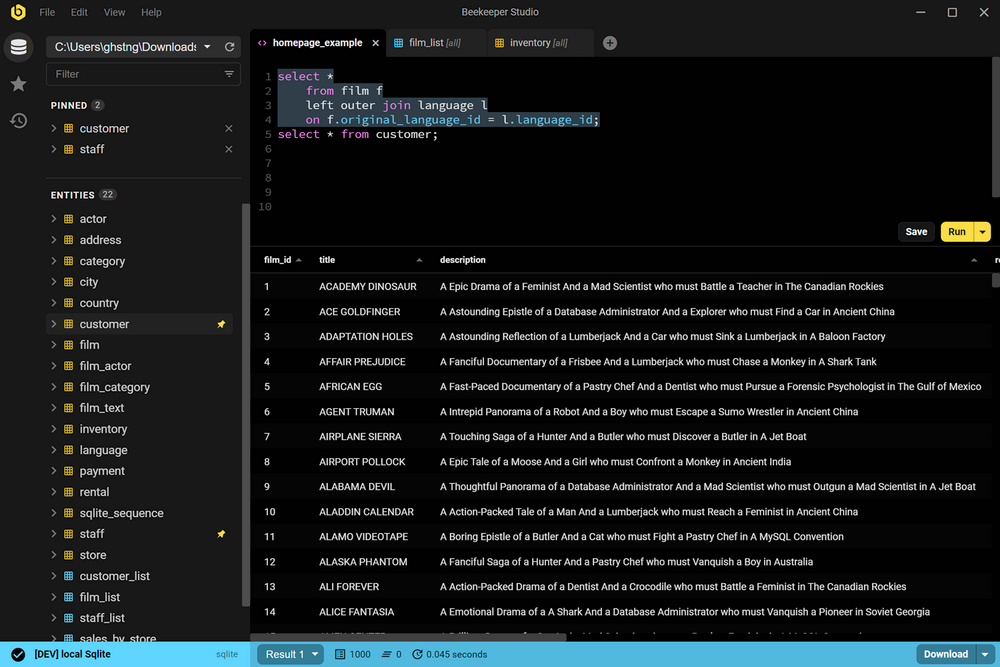
Beekeeper Studio is a powerful cross-platform SQL editor and database manager that you can use on Linux, Mac, and Windows.
The Community Edition of Beekeeper Studio is licensed under GPL, making it both free (libre) and free (gratis).
Features of the Free community edition
- Truly cross-platform: Windows, MacOS, and Linux
- Autocomplete SQL query editor with syntax highlighting
- Tabbed interface, so you can multitask
- Sort and filter table data to find just what you need
- Sensible keyboard-shortcuts
- Save queries for later
- Query run-history, so you can find that one query you got working 3 days ago
- Default dark theme
Supported platforms
- MySQL, MariaDB
- SQLite
- PostgreSQL
- CockroachDB
- SQL Server
- Amazon Redshift
Cons
- Some cool features are locked in the commercial edition
- Oracle Database, and Cassandra Database are exclusive for the commercial edition
6- Qt Creator SQL database viewer plugin

Qt Creator IDE is an integrated development environment (IDE) specifically designed for developing applications using the Qt framework.
It provides a comprehensive set of tools and features for creating cross-platform desktop, mobile, and embedded applications.
This is an extension/ plugin for Qt Creator IDE that enables you to edit and modify SQL databases directly.
7- SQL Viewer (Google Chrome Extension)

This is a cool simple yet powerful SQL viewer that turns your Google Chrome and similar browsers into a cool SQL viewer tool.
Pros
- Load SQL files directly
- Browse cloud SQL files
- Minify code
Cons
- Basic SQL viewer and editor for professionals.
8- SQLite Viewer (Web App)
This is an open-source free ReactJS web app called SQLite Viewer allows users to view and interact with SQLite databases directly in the browser.
9- Falcon
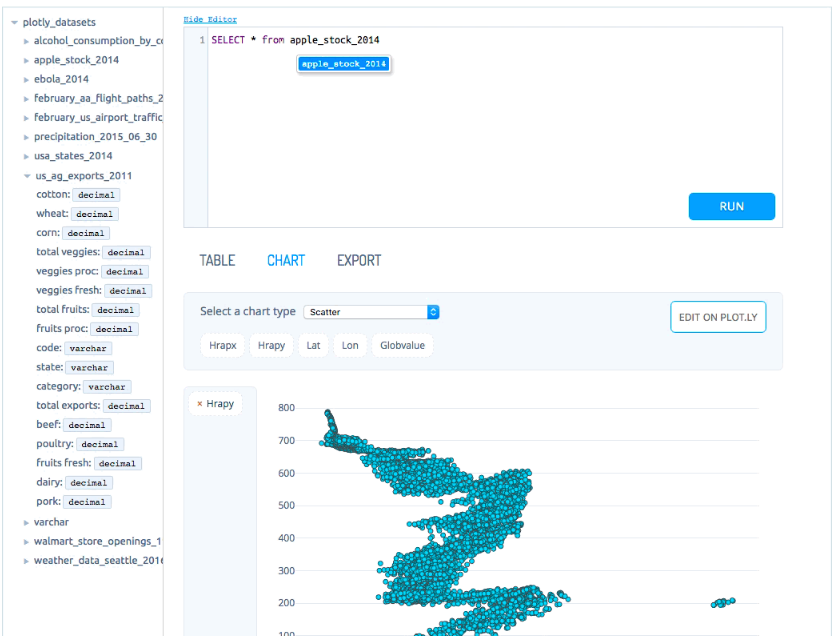
Falcon is a free, open-source SQL editor with inline data visualization that supports various databases. It can be used offline and does not require a Plotly Chart Studio account.
The company behind Falcon is focusing on Dash Open Source and Dash Enterprise for analytical backends.
Pros
- Built primarily for data engineers and data analytics
Cons
- For advanced users
10- SQLite Viewer for VSCode

VSCode is a popular code editor and IDE with a vast ecosystem of extensions and theme.
This extension allows you to turn your VSCode into a powerful SQLite viewer and editor with just one click.
Features
- Platform-independent, no native dependencies — now working on VSCode for Web
- File extension association: Just click on a
.sqlitefile and the custom viewer opens - Fast UI with virtualized scrolling, sorting, filtering, etc.
- Seamlessly integrates with VSCode and matches your color theme
Caveats
- Cached and Readonly
- Only works for files that fit in system memory
- No query runner
- Requires uncorrupted files, i.e.
-journaland-walfiles are ignored
11- SQL Viewer for SQLite (Web-based)
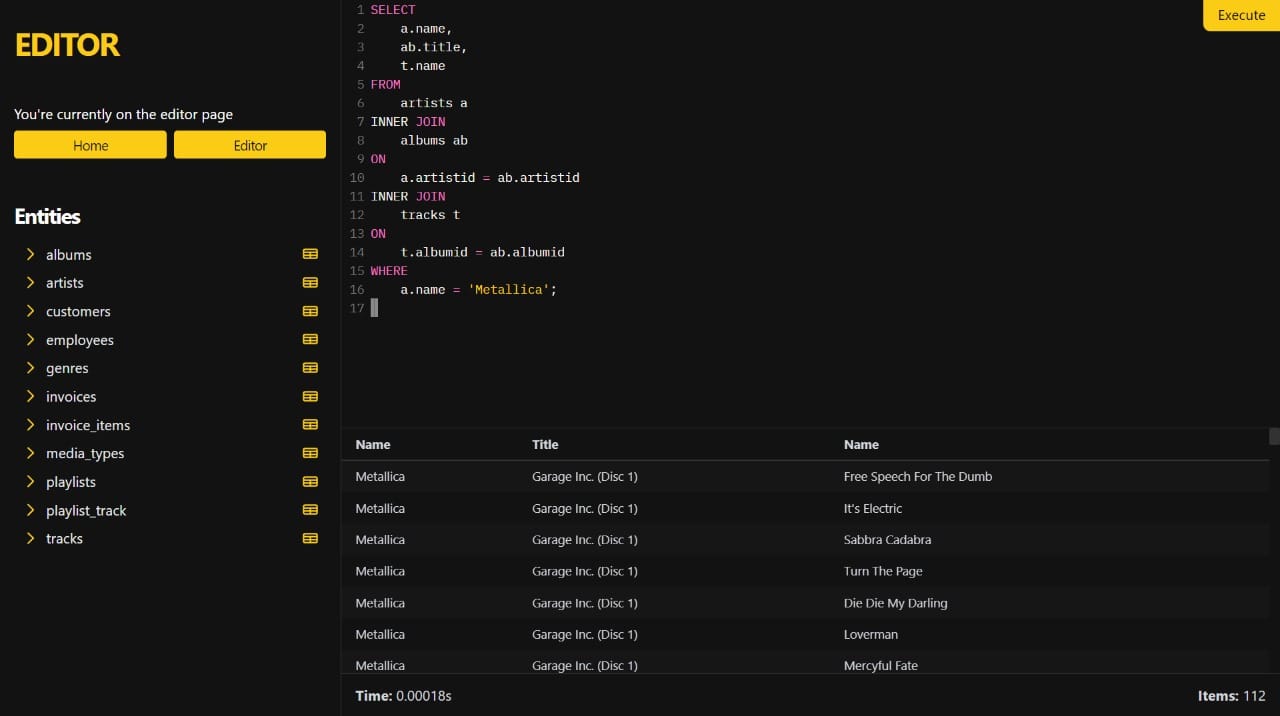
This is a simple web-based SQLite viewer that is written using Python and comes with a simple web interface.
12- DB Browser for SQLite
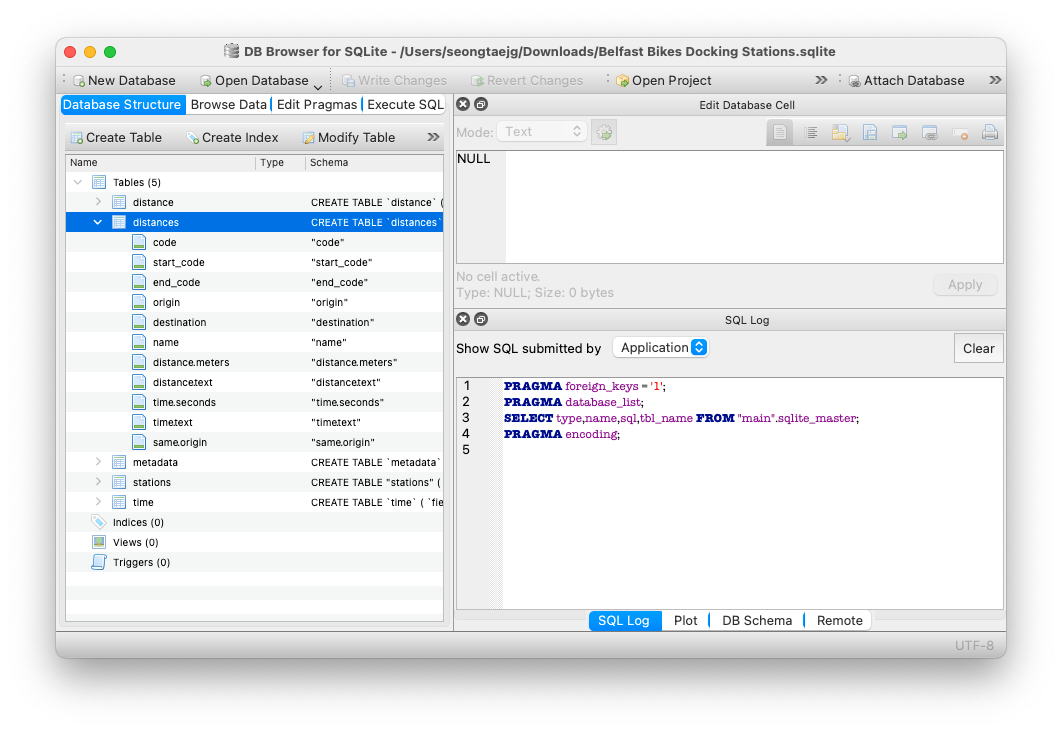
DB Browser for SQLite (DB4S) is an open-source tool that allows users and developers to create, design, and edit SQLite database files. It provides a user-friendly interface similar to a spreadsheet, eliminating the need to learn complex SQL commands.
DB Browser for SQLite is bi-licensed under the Mozilla Public License Version 2, as well as the GNU General Public License Version 3 or later.
Features
- Create and compact database files
- Create, define, modify, and delete tables
- Create, define, and delete indexes
- Browse, edit, add, and delete records
- Search records
- Import and export records as text
- Import and export tables from/to CSV files
- Import and export databases from/to SQL dump files
- Issue SQL queries and inspect the results
- Examine a log of all SQL commands issued by the application
- Plot simple graphs based on table or query data
Cons
- Limited convenience functions beyond simple database frontend
- Some functions may not make sense in a database context
- Complex functions may be a poor replacement for favorite spreadsheet application
Platforms
- Windows
- Linux: Debian, Linux Mint, Ubuntu, Fedora, Arch Linux, openSUSE
- macOS
- FreeBSD
13- MySeea
MySeea is an SQL Viewer project, specifically a MySQL Database Viewer, that allows users to connect with any MySQL Web Database and view tables. The project is currently in active development and aims to add the ability to edit tables in future updates.
The program stores all data locally and is in BETA with minimal features available.
MySeea is a minimal app that is written using Python and Tkinter.
Features
- Connect/Disconnect to MySQL Database
- Read Tables
- Keybinds and Shortcuts
- Clean Look
- Interactive Help Menu
Cons
- Program may not work on Linux or macOS
- Still in BETA with limited features
- Bugs may be present due to the development stage
14- Litespread (SQLite)

Litespread is an SQL viewer and editor for SQLite and CSV files that offers basic spreadsheet functionality.
It allows you to save files that can be used with other SQLite compatible software without losing formatting, formulas, aggregate rows, and views.
The app is written using JavaScript and can be deployed easily on any server or the local machine.
15- SQLite Viewer

An SQL Viewer is a tool that allows you to view SQLite files online. It uses sql.js for parsing the files and can also load remote files.
16- MySQL-GUI-Viewer
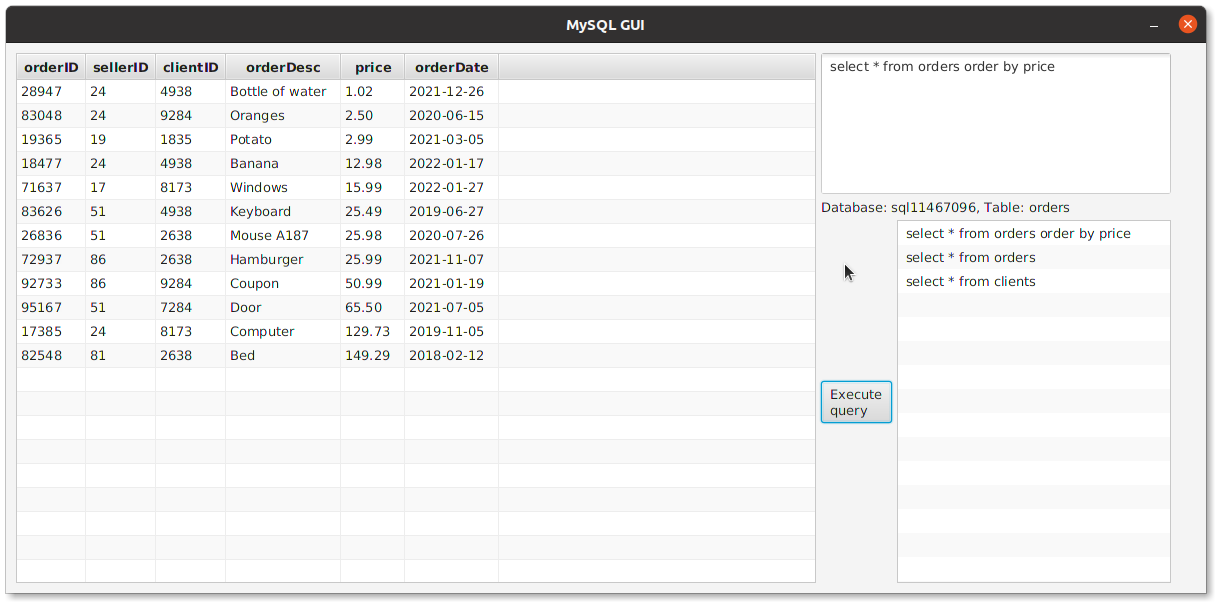
An SQL viewer is a tool that allows you to view and interact with SQL databases. It is particularly useful for managing and analyzing data stored in MySQL databases. The MySQL-GUI-Viewer is a specific SQL viewer that uses JavaFX for its user interface.
17- Ocelot GUI

The ocelotgui GUI, an exceptional database client, empowers users to effortlessly connect to a MySQL or MariaDB DBMS server, effortlessly input SQL statements, and promptly receive accurate results.
It boasts a remarkable array of features, including syntax highlighting, customizable colors and fonts for every aspect of the screen, result-set displays with multi-line rows and resizable columns, and an advanced debugger.
Features
The ocelotgui GUI is an exceptional database client that offers the following features:
- Effortless connection to MySQL or MariaDB DBMS servers
- Easy input of SQL statements
- Prompt and accurate results
- Syntax highlighting for improved readability
- Customizable colors and fonts for a personalized experience
- Result-set displays with multi-line rows and resizable columns
- Advanced debugger for efficient troubleshooting
Cons
- The UI may be outdated.

18- DbGate - (no)SQL database client

DbGate is cross-platform database manager. It's designed to be simple to use and effective, when working with more databases simultaneously. But there are also many advanced features like schema compare, visual query designer, chart visualisation or batch export and import.
DbGate is licensed under MIT license and is completely free.
Pros
- Works as a desktop app or a web app
- Supports macOS, Window and Linux
- Easy to install as a Docker image
- Comes with advanced features, SQL viewer, editor, query manager, and more
Supported databases
- MySQL
- PostgreSQL
- SQL Server
- Oracle (experimental)
- MongoDB
- Redis
- SQLite
- Amazon Redshift
- CockroachDB
- MariaDB
Features
- Table data editing, with SQL change script preview
- Edit table schema, indexes, primary and foreign keys
- Compare and synchronize database structure
- ER diagram
- Light and dark theme
- Master/detail views, foreign key lookups
- Query designer
- Form view for comfortable work with tables with many columns
- JSON view on MongoDB collections
- Explore tables, views, procedures, functions, MongoDB collections
- SQL editor
- execute SQL script
- SQL code formatter
- SQL code completion
- Add SQL LEFT/INNER/RIGHT join utility
- Mongo JavaScript editor, execute Mongo script (with NodeJs syntax)
- Redis tree view, generate script from keys, run Redis script
- Runs as application for Windows, Linux and Mac. Or in Docker container on server and in web Browser on client.
- Import, export from/to CSV, Excel, JSON, NDJSON, XML
- Free table editor - quick table data editing (cleanup data after import/before export, prototype tables etc.)
- Archives - backup your data in NDJSON files on local filesystem (or on DbGate server, when using web application)
- Charts, export chart to HTML page
- For detailed info, how to run DbGate in docker container, visit docker hub
- Extensible plugin architecture
- Perspectives - nested table view over complex relational data, query designer on MongoDB databases
19- MySQL Workbench
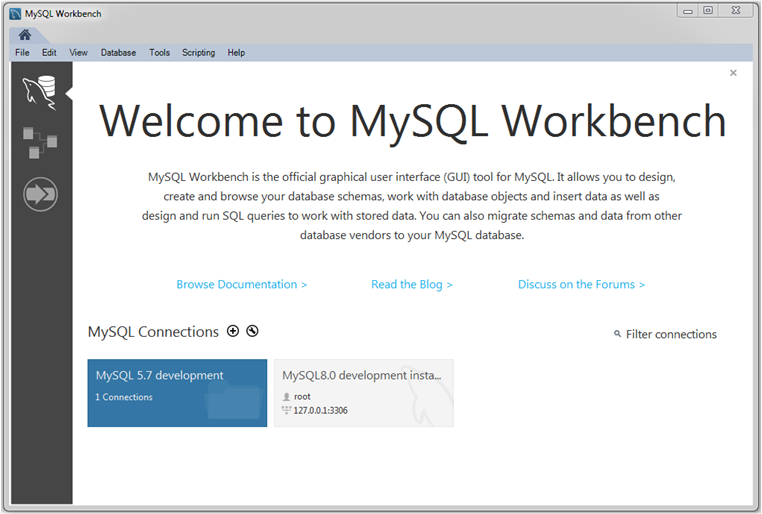
MySQL Workbench is a visual database design and administration tool developed by Oracle. It provides a comprehensive set of features for database development, modeling, management, and SQL query execution.
With MySQL Workbench, users can create, modify, and manage MySQL databases, design and visualize database schemas using Entity-Relationship (ER) diagrams, and execute SQL queries and scripts.
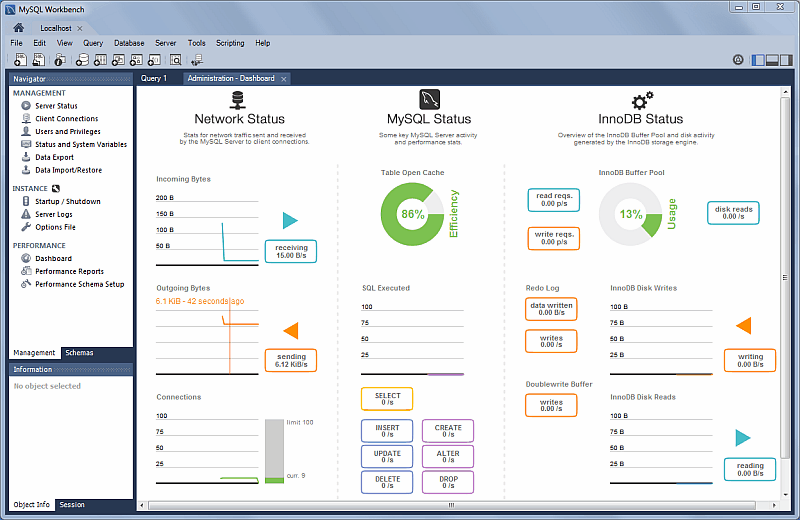
Key Features
Some key features of MySQL Workbench include:
- Visual database modeling: Allows users to create and modify database schemas using intuitive drag-and-drop tools and visual ER diagrams.
- SQL development: Provides a powerful SQL editor with syntax highlighting, code completion, and version control integration for writing and executing SQL queries, stored procedures, and functions.
- Database administration: Offers tools for managing database users, privileges, and server configuration settings, as well as monitoring and optimizing database performance.
- Data migration: Simplifies the process of migrating data from other database systems to MySQL, supporting various source databases and providing data mapping and transformation capabilities.
- Database backup and restore: Enables users to perform full or incremental backups of MySQL databases and restore them when needed.
- Query optimization: Provides tools for analyzing query performance, identifying and resolving performance bottlenecks, and generating query execution plans.
- Collaboration and teamwork: Supports collaborative database development by allowing multiple developers to work on the same database project simultaneously, with features like version control integration and schema synchronization.
- Cross-platform compatibility: MySQL Workbench is available for Windows, macOS, and Linux operating systems, allowing users to work on their preferred platforms.
20- Adminer
Adminer is a lightweight and full-featured database management tool written in PHP. It provides a user-friendly web interface that allows users to easily manage and manipulate their databases.
Adminer supports various database systems, including MySQL, PostgreSQL, SQLite, Oracle, and more.
Pros of Adminer:
- Lightweight and easy to install
- Simple and intuitive user interface
- Supports multiple database systems
- Provides essential features for managing databases, such as querying, table creation/modification, data import/export, and more
- Supports customization through plugins and themes
Cons of Adminer:
- Limited advanced features compared to other database management tools
- May not be suitable for complex or enterprise-level database management tasks
- Relies on PHP, which may introduce performance limitations
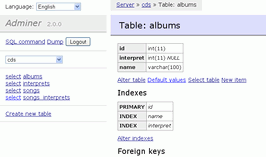
21- phpMyAdmin
phpMyAdmin is a popular web-based database management tool specifically designed for MySQL databases.
It offers a comprehensive set of features for managing MySQL databases, including database administration, query execution, table creation/modification, data import/export, and more.
Pros of phpMyAdmin:
- Feature-rich and highly customizable
- Supports advanced database management tasks, such as user management, server configuration, and database replication
- Provides a wide range of import/export options, including CSV, SQL, and XML
- Active community support and regular updates
Cons of phpMyAdmin:
- Requires a web server with PHP support for installation
- Can be resource-intensive for large databases or high-traffic environments
- May have a steeper learning curve compared to simpler database management tools

22- HeidiSQL
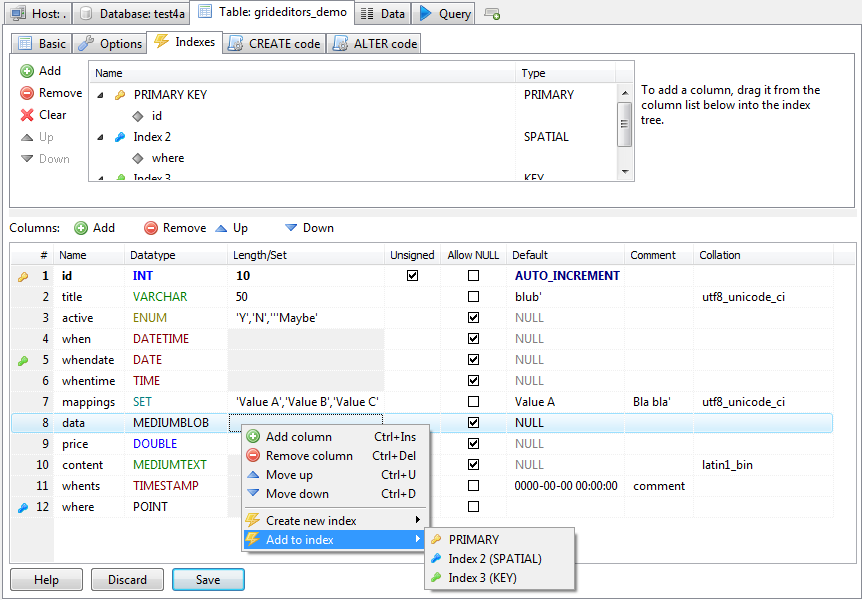
HeidiSQL is a powerful and user-friendly software that is available for free. Its main objective is to provide an intuitive learning experience.
"Heidi" allows users to effortlessly view and modify data and structures from various database systems, including MariaDB, MySQL, Microsoft SQL, PostgreSQL, and SQLite.
Developed by Ansgar in 2002, HeidiSQL has gained immense popularity and is widely regarded as one of the most essential tools for MariaDB and MySQL users across the globe.
Features
- Intuitive learning experience
- View and modify data and structures from various database systems (MariaDB, MySQL, MS SQL, PostgreSQL, SQLite, Interbase, and Firebird)
- Connect to multiple servers in one window
- Connect via command-line or SSH tunnel with SSL settings
- Create and edit tables, views, stored routines, triggers, and scheduled events
- Generate SQL exports, compress them, or copy them to the clipboard
- Export data from one server/database to another
- Manage user privileges
- Import text files
- Export table rows in various formats (CSV, HTML, XML, SQL, LaTeX, Wiki Markup, and PHP Array)
- Browse and edit table data using a comfortable grid
- Bulk edit tables (move to a different database, change engine, collation, etc.)
- Batch-insert ASCII or binary files into tables
- Write queries with customizable syntax highlighting and code completion
- Reformat disordered SQL for better readability
- Monitor and kill client processes
- Find specific text in all tables of all databases on a server
- Optimize and repair tables in a batch manner
- Launch a parallel mysql.exe command-line window using current connection settings
Cons
- Requires installation and setup on a local machine
- May have a learning curve for users unfamiliar with SQL and database management
- Limited to the features provided by the software, may not cover all advanced database management functionalities
- May not be suitable for enterprise-level or complex database management tasks
23- pspg - Postgres Pager
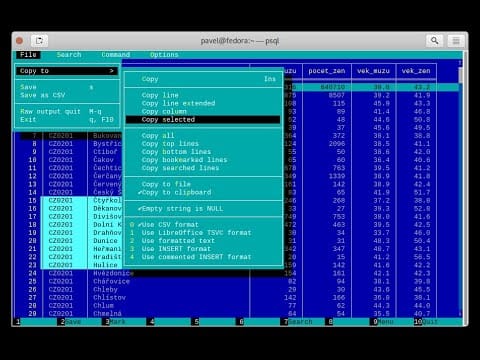
An SQL Viewer is a specialized pager that provides support for tabular data and can be used with command line clients like psql, mysql, sqlite, and others. It offers features such as freezing rows or columns, sorting data by numeric columns, and using fancy themes.
It is made primarily for PostgreSQL but also supports MySQL, MariaDB, and SQLite.
24- SQL Browser
SQL Viewer is a simple database browser for ODBC compliant databases, designed for Windows.
It provides a powerful SQL interface for Dyalog APL users, allowing them to quickly and securely handle database credentials and access tables/columns without needing to read documentation or remember specific names. EasyGUI is a required dependency for this library.
Cons
- Requires advanced skills to setup
- Does not provide support for all platforms
- No binary packages
25- SQLite Viewer
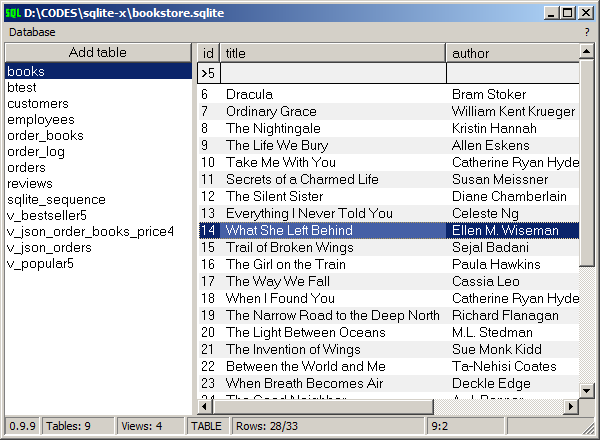
sqlite-x is the ultimate SQLite viewer for Windows users who prefer a query-free experience.
Features
- Column filters
- Sort data by column click
- Data editing
- Doesn't require SQLite library (built-in)
- Supports huge tables
- Blob export
Conclusion
An SQL Viewer is a tool that can benefit database administrators, data analysts, and software developers by simplifying data access and manipulation. It offers advanced features such as query optimization, data export options, and database connection management.
Here in this list, we displayed the best open-source free SQL viewer and clients that you can download and use for free. However, you may need to check your project requirements, and match the right ones to your needs and skills.


